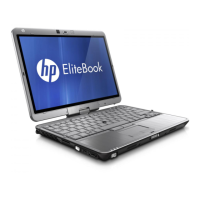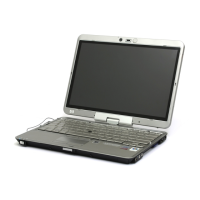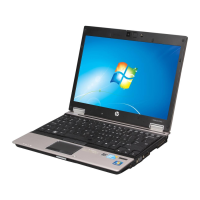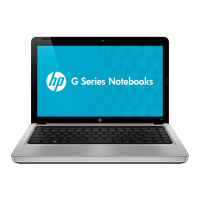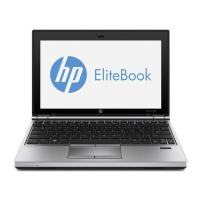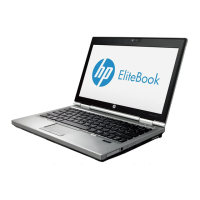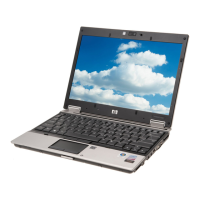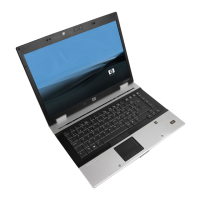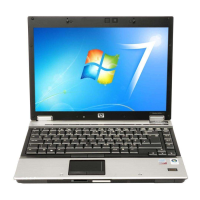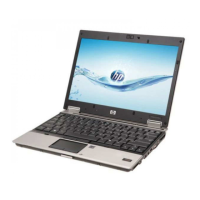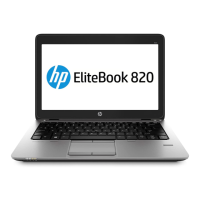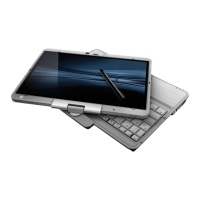
Do you have a question about the HP EliteBook 2740p and is the answer not in the manual?
| Bus type | DMI |
|---|---|
| Stepping | C2 |
| Tjunction | 105 °C |
| Processor cache | 3 MB |
| Processor cores | 2 |
| System bus rate | 2.5 GT/s |
| Processor family | Intel® Core™ i5 |
| Processor series | Intel Core i5-500 Mobile Series |
| Processor socket | BGA 956 |
| Processor threads | 4 |
| Processor codename | Arrandale |
| Processing Die size | 81 mm² |
| Processor frequency | 2.53 GHz |
| Processor cache type | Smart Cache |
| Processor technology | Intel Centrino 2 w/ vPro |
| Processor lithography | 32 nm |
| Processor manufacturer | Intel |
| Processor front side bus | - MHz |
| PCI Express slots version | 2.0 |
| Processor boost frequency | 3.07 GHz |
| Processor operating modes | 64-bit |
| ECC supported by processor | No |
| PCI Express configurations | 1x16 |
| Thermal Design Power (TDP) | 35 W |
| CPU multiplier (bus/core ratio) | 19 |
| Maximum number of PCI Express lanes | 16 |
| Number of Processing Die Transistors | 382 M |
| Display | - |
| Modem speed | 56 Kbit/s |
| Battery type | HP Long Life 6-cell (39 WHr) Lithium-Ion Primary Battery |
| Graphics card | HD Graphics |
| Internal modem | Yes |
| Expansion slots | 1 Express Card/34; 1 Smart Card Reader; 1 secure digital/MultiMedia card |
| Video card note | Microsoft DirectX 10 (Shader 4.0) and OpenGL 2.1 capable, with DDR3 system memory |
| Dimensions (WxDxH) | 290 x 212 x 31.7 mm |
| Power requirements | External 65W Smart AC adapter; Power cord (1.8 meters, with AC adapter 3.66 meters); HP Fast Charge |
| HDD controller type | Solid State Drive SATA II (5400 rpm) |
| Wireless technology | Intel 802.11a/b/g; HP Integrated Module with Bluetooth 2.1 Wireless Technology |
| Maximum HDD capacity | 320 GB |
| Intel segment tagging | Enterprise |
| Minimum storage drive space | 160 GB |
| Compatible operating systems | Genuine Windows Vista Enterprise 32; Genuine Windows Vista Enterprise 64; Genuine Windows 7 Home Premium; SuSE Linux Enterprise 10 |
| Main camera resolution (numeric) | 2 MP |
| Bluetooth version | 2.1+EDR |
| Networking features | Integrated Intel 82577 Gigabit Ethernet (10/100/1000 NIC) |
| Operating temperature (T-T) | 5 - 35 °C |
| Storage relative humidity (H-H) | 5 - 95 % |
| Operating relative humidity (H-H) | 10 - 90 % |
| Memory slots | 2x SO-DIMM |
| Memory upgrade | 8 GB |
| Internal memory | 4 GB |
| Memory clock speed | 1333 MHz |
| HDD capacity | 0 GB |
| SSD capacity | The Solid State Drive's storage capacity in Gigabytes. |
| Display diagonal | 12.1 \ |
| Display resolution | 1280 x 800 pixels |
| Native aspect ratio | 16:10 |
| Audio system | HD |
| Audio included | High Definition Audio support with 24-bit DAC, Integrated stereo speakers, Integrated dual-microphone array, Touch-sensitive controls for volume up, volume down, and mute, Combo headphone/mic jack |
| Motherboard chipset | Intel® QM57 Express |
| I/O ports | 3 USB 2.0; 1 1394a; 1 AC power; 1 combo stereo headphone/mic jack; 1 docking connector; 1 RJ-11; 1 RJ-45; 1 secondary battery connector; 1 VGA-in |
| Charging port type | DC-in jack |
| USB 2.0 ports quantity | 3 |
| Firewire (IEEE 1394) ports | 1 |
| Number of battery cells | 6 |
| Trial software | WinZip 12; Microsoft Office Professional 2007; HP SkyRoom |
| Bundled software | HP Recovery Manager; HP Support Assistant; HP QuickLaunch Buttons; HP QuickLook 3; HP QuickWeb; HP DayStarter; HP Power Assistant; HP Connection Manager; HP Wireless Assistant |
| Operating system installed | Windows 7 Professional |
| Form factor | Convertible (Swivel) |
| Product type | Hybrid (2-in-1) |
| Country of origin | China |
| Storage drive type | 160 GB Solid State Drive SATA II Hard Drive 160, 250 or 320 GB (5400 rpm), Solid State Drive 80 or 160 GB, HP 3D DriveGuard |
| Keyboard type | HP spill-resistant keyboard, HP Night Light shines directly on the keyboard for low-light conditions |
| Keyboard layout | QWERTY |
| Processor ARK ID | 43544 |
| Processor package size | rPGA 37.5x 37.5, BGA 34x28 mm |
| Graphics & IMC lithography | 45 nm |
| Supported instruction sets | SSE4.1/4.2 |
| Intel® Turbo Boost Technology | 1.0 |
| Physical Address Extension (PAE) | 36 bit |
| On-board graphics card model | Intel® HD Graphics |
| On-board graphics card base frequency | 500 MHz |
| On-board graphics card dynamic frequency (max) | 766 MHz |
| Depth | 212 mm |
|---|---|
| Width | 290 mm |
| Height | 31.7 mm |
| Weight | 1720 g |
Locate and identify the various hardware components of the computer.
An overview of the main components located on the top of the computer.
Explanation of the function and meaning of various indicator lights on the computer.
Identification and function of buttons and switches on the computer.
Description of the function of various keys on the keyboard, including Fn and function keys.
Identification of hardware components located on the front of the computer.
Identification of hardware components located on the right side of the computer.
Identification of hardware components located on the left side of the computer.
Identification of hardware components located on the rear of the computer.
Identification of hardware components located on the bottom of the computer.
Details about the computer's display, including webcam and touch screen.
Information about wireless antennas and their functions on select models.
Information about additional hardware components like power cord and battery.
Information on how to identify various labels on the computer for troubleshooting.
Identification of components related to the tablet display and its functions.
Instructions on how to rotate the computer display between notebook and tablet modes.
Steps to convert the computer into tablet mode by rotating the display.
Steps to convert the computer back into notebook mode from tablet mode.
Information on using wireless devices like WLAN and Bluetooth on select models.
Instructions and considerations for connecting to and protecting a Wireless Local Area Network.
Guide to using HP Mobile Broadband for wireless wide area network connectivity.
Information on connecting and using Bluetooth devices for short-range wireless communication.
Common causes and solutions for issues encountered when connecting to wireless networks.
Instructions for connecting and using the computer's modem on select models.
Steps for connecting the computer to a wired local area network.
Information on customizing settings for pointing devices like the TouchPad and mouse.
Instructions on using the TouchPad for cursor movement, scrolling, and gestures.
Guide on how to use the digitizer pen for writing, clicking, and other functions.
Steps to calibrate the pen for optimal performance and handwriting recognition.
How to adjust pen-specific settings and preferences in the operating system.
Instructions on interacting with the touch screen using gestures like tapping and flicking.
Information on keyboard features including the keyboard light and hotkeys.
Explanation of function keys (Fn) combined with other keys for quick access to features.
Overview of the computer's multimedia capabilities like audio and video playback.
How to control the computer's audio volume using buttons and software controls.
Information about preinstalled and optional multimedia software for managing media.
Details on audio features, connecting external audio devices, and checking functions.
Information on video features, connecting external monitors, and using the webcam.
Guide to using the integrated webcam for photos, video, and audio recording.
How to adjust webcam settings such as brightness, contrast, and hue for optimal image quality.
Instructions on using the webcam and software to capture and process business card information.
Configuration of power-saving states like Sleep and Hibernation.
How to view battery status, power plans, and manage battery meter icon settings.
Connecting the computer to external AC power using the adapter or docking devices.
Information on running the computer on battery power and managing battery life.
Procedure for safely inserting and removing the computer's battery.
Guidelines and tips for charging the computer battery effectively.
Tips and settings to extend the battery discharge time and conserve power.
Understanding alerts for low battery levels and the computer's responses.
Procedure for calibrating the battery to ensure accurate charge displays.
Recommendations for safely storing the battery when the computer is unused.
Troubleshooting steps to test the AC adapter if the computer exhibits power issues.
Recommended procedure for properly shutting down the computer.
How to view the hard drives and SSDs installed on the computer.
Precautions and best practices for handling fragile drive components.
Methods to enhance hard drive performance, including Disk Defragmenter and Cleanup.
Information on HP 3D DriveGuard for protecting the hard drive during movement.
Step-by-step instructions for removing and replacing the hard drive.
Instructions for connecting and safely removing USB devices.
Enabling USB legacy support in Computer Setup for startup and DOS compatibility.
Information on connecting and removing IEEE 1394 devices like cameras.
Options for expanding storage with external drives via USB or other interfaces.
How to connect the computer to an optional docking device for expanded connectivity.
Information on using optional digital cards like SD and MMC for data storage.
Procedure for safely inserting digital cards into the Media Card Reader.
Procedure for safely removing digital cards from the Media Card Reader.
Instructions for configuring, inserting, and removing ExpressCards on select models.
Information on using smart cards, including insertion and PIN-based access.
Step-by-step guide to upgrading or replacing memory modules in the computer.
Overview of security features to protect the computer and data from unauthorized access.
Guidance on creating, saving, and managing passwords for system security.
Details about the BIOS administrator password and its characteristics.
Steps to set, change, or delete the BIOS administrator password in Computer Setup.
Information on DriveLock protection for hard drives and its password considerations.
Procedure to set user and master passwords for DriveLock protection in Computer Setup.
Steps to remove DriveLock protection from a hard drive via Computer Setup.
How to enable Automatic DriveLock for enhanced hard drive security.
How to secure system devices like boot options and ports via Computer Setup.
Information on using antivirus software to protect against computer viruses.
How to use firewall software to protect personal files and information.
Importance of installing critical updates from Microsoft for security protection.
Instructions for physically securing the computer using a security cable.
How to update computer software and drivers via HP Assistant or the HP website.
Procedure for determining the current BIOS version and downloading/installing updates.
Steps to download and install the latest programs and device drivers.
Methods for backing up personal files, system images, and recovery discs.
Using Windows recovery tools, f11, or a Windows 7 DVD for system recovery.
Procedure to recover the original hard drive image using the f11 key.
How to access and start the Computer Setup utility before the OS loads.
Instructions on navigating menus and making selections within Computer Setup.
Procedure to reset all Computer Setup settings to their factory default values.
Options available in the File menu of Computer Setup, such as System Information.
Security-related options within Computer Setup, including password management.
Configuration options within Computer Setup, including boot order and device settings.
Understanding how the system selects boot devices and the order of priority.
How to enable devices like USB drives or NICs as bootable options in Computer Setup.
Important considerations before changing the computer's boot device order.
Options for setting boot order and dynamically selecting boot devices.
Overview of software solutions for managing client computers in a network.
Methods for deploying customized software images to computers.
Tools and procedures for managing and updating software on client computers.
Details on HP Client Manager for Altiris for hardware and software management.
Automating software management, updates, and configuration for computers.
Remotely updating system-level software and drivers using HP SSM.
Information on Intel AMT for managing computers on or off the network.
How to use the HP Universal Print Driver for printing to HP networked printers.
Recommended products for safely cleaning and disinfecting the notebook or tablet PC.
Step-by-step instructions for safely cleaning the computer's exterior components.
Instructions for gently cleaning the computer's display screen.
How to clean and disinfect the sides and outer cover of the computer.
Procedure for cleaning the TouchPad and keyboard, avoiding liquid damage.
How to clean the digitizer pen and its holder.
